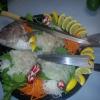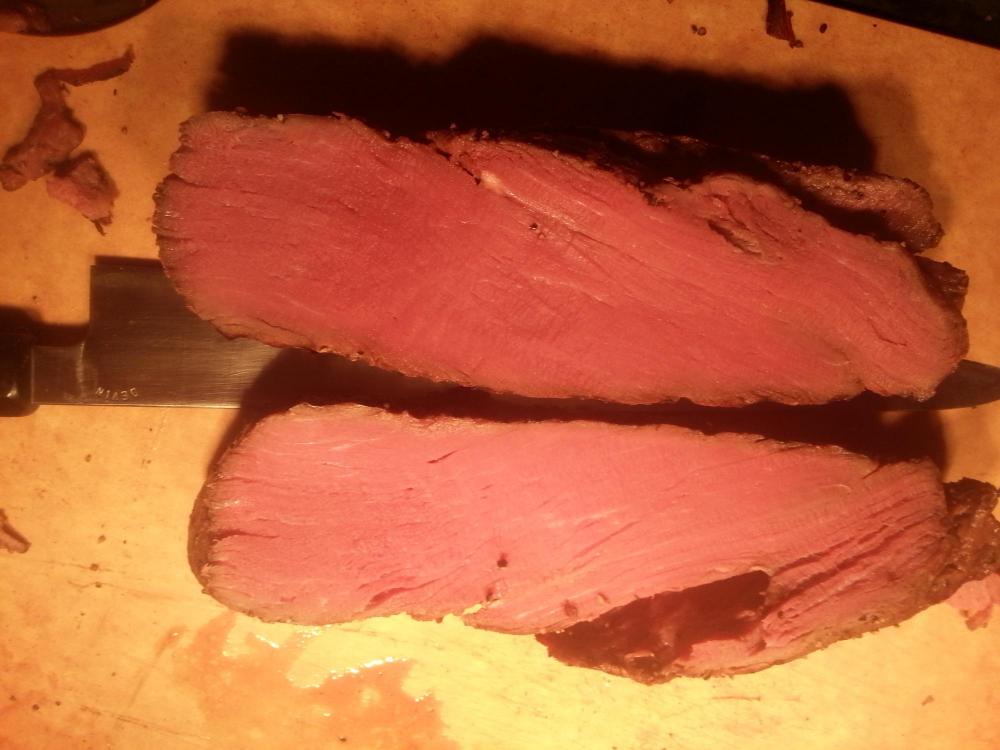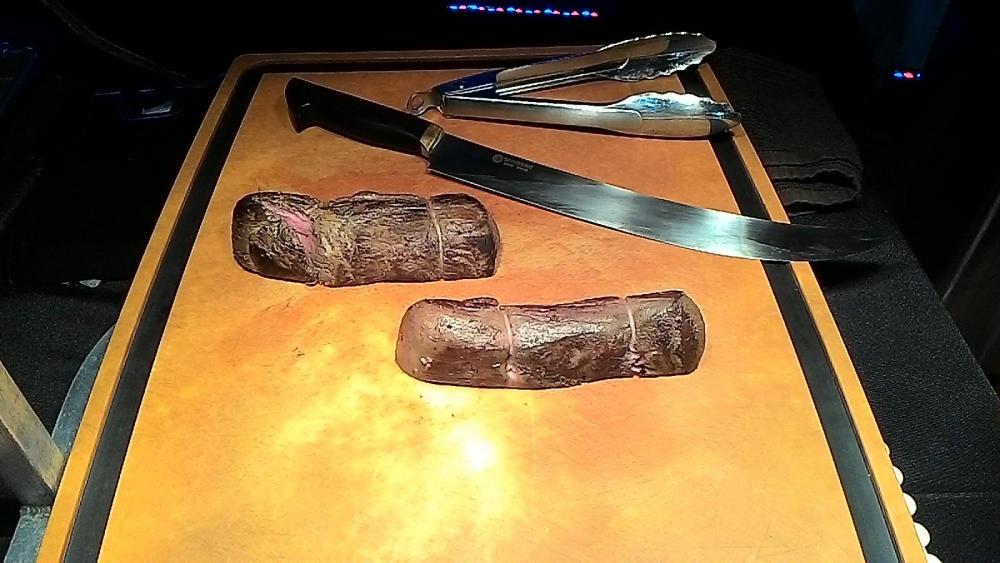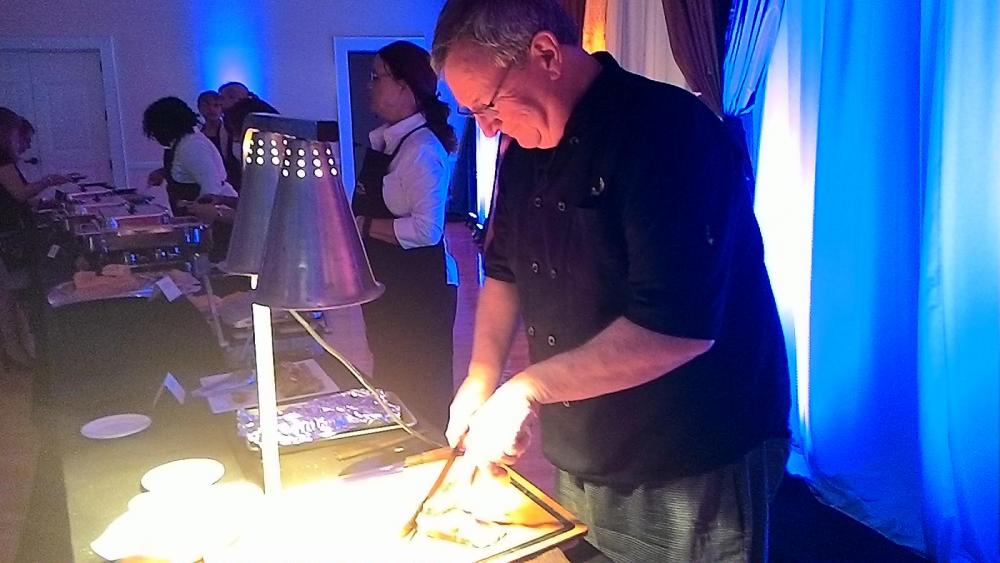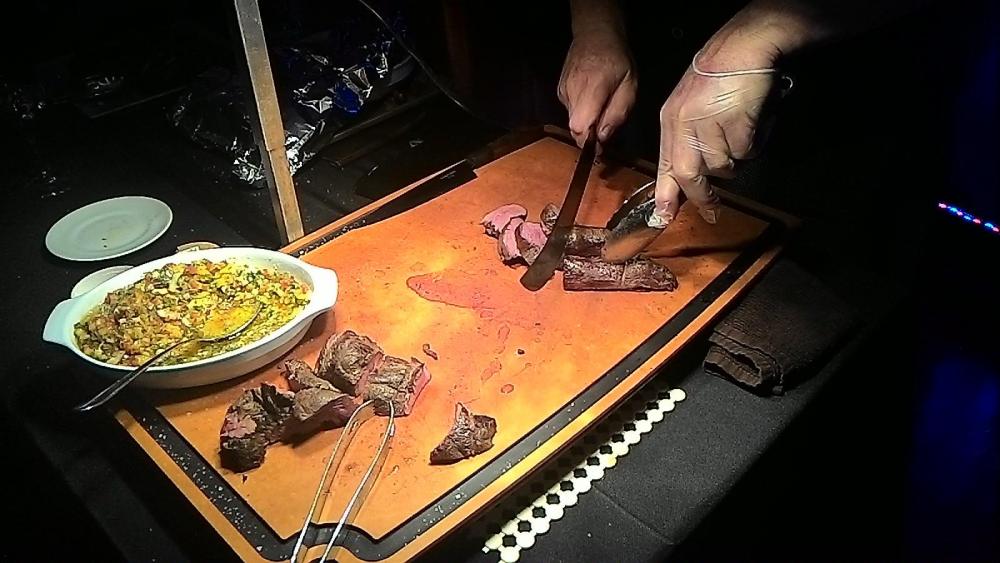-
Posts
386 -
Joined
-
Last visited
Content Type
Profiles
Forums
Store
Help Articles
Everything posted by daveb
-
Food stylist. For the sear to be that uniform, some form of hot fat had to be basted over the steak. The puddle is likely the basting juices. The thyme sweeping left, the knife sweeping right, drawing the reader to the centered column of perfectly presented beef. People get paid for that???
-
A value strip sealer can be had for about 100 bucks. A good (Weston, Ary, etc) strip sealer is in the 3 - 400 bracket. Today's price on a Vacmaster 112S Chamber Sealer is 469 from WebRestaurant. (It's 50 pounds shipping weight but it's a heavy 50 pounds.) I've done Sous Vide with each category of sealer and while each is doable the chamber sealer is far and away the best suited for it. And of course at the other end of the Sous Vide spectrum are the folks that do the immersion sealing. In my frequently wrong but never in doubt opinion: The chamber wins on ease of use, efficiency, product reliability, functional reliability, bag cost and versatility. Infused cocktails anyone? This is particularly true for more adventurous cooks who pursue things like "modern cuisine". It loses a little on price and it is heavy. Many if not most folks will be well served by a value strip sealer. I think that's your target audience.
-
A brief perusal here will show that most sealer discussions concern differences between the oil pump or not oil pump chamber sealers, who has the best price for chamber sealers, where to buy pre-cut bags in quantities less than 1,000, etc. Your article seems geared towards a more casual audience - and there's nothing wrong with that. Noticed a brief segue into Sous Vide in your article. Will you be an expert there next? Good luck in your endeavor.
-
To match your shoes Until today I did not know that "bacon" and "wasabi" were colors....
-
Cooking for friends, family and loved ones is why we do this. I admire your response to one of life's challenges.
-
In Florida there are a few bays on the gulf coast where recreational scalloping is permitted (once you buy a license of course). The two month season is popular across the state, especially among younger folks. The scallops are harvested by snorkeling, lots of snorkeling. There are harvest limits per person on the boat, if I recall correctly a limit is 5 gallons of in the shell or 1 quart shucked. I used to participate more actively but now when I can go I stay in the boat and act as a limit extender / shucker.. Most people shuck the scallops on the boat. It minimizes the mess and more scallops are allowed when shucked. They are put in quart containers and kept in a cooler. Best to use them that day or the next. Or freeze them. Unshucked scallops will last longer. They are kept in a 5 gallon bucket on the boat and then transferred to a cooler when ashore. Kept on ice with a drain plug so that they are not in water, they will last a couple three days before they need to be shucked and eaten or frozen. To the OPs question (realizing its probably obe by now) I would keep them in the packaging they arrive in adding ice as appropriate. Shuck them the morning of use. Keep them cold until they go into the skillet. This reminds me that scallops are in season now. May have to go.
-
I know of at least one restaurant that does.... Salmon is a big seller, especially among our aging population. 104F makes a great app for the metros. Pre-portioned and SV filets have virtually eliminated send backs for over cooking, under cooking. I cook it SV at home as well. I like it seared, some don't. Also great as prep for fish tacos with any fish. (Most popular food truck dish) For halibut, I would portion fish then bag it. Brief SV as described above. Sear in pan or with torch, sauce, garnish and serve.
-
My reluctance to having bottled bleach in the kitchen is because of the possibiliy of a spill and because I have no use that requires it in undiluted form. I use the Clorox product "Soft Scrub" to clean/sanitize poly, Sani-tuff or Epicurean boards that I use for proteins. I use these at home, on a food truck, catering and in a restaurant. Thorough rinse after. The soft scrub is not specifically recognized as food safe so for the commercial applications I use the soft scrub first then go through the approved washing/sanitizing for each. Boards are clean and everybody is happy. Also use the soft scrub product to clean coolers, bottom of the fridge, food pans, etc. Any place funky that I want clean. Now back to building the watch... insert smiley here
-
Pls report back w pics. Too late to talk you into 131F?
-
An easy way to think of beef is to divide into "steak" cuts and "butcher" cuts. The steaks, tenderloin, t=bone, strip and ribeye, do not need the tenderizing that the butcher cuts do. I use roughly 1 hr/inch for steaks. Have tried shortcut a tenderloin once and had it in bath for less than 2 hours (meeting a schedule) and the beef looked right, temped right, but had a raw consistency when chewing. Have not had any problems with steak going to mush when left in for 1.5x cook time. The butcher cuts are the tougher pieces that need to break down while in the bath. Including the sirloin. For these I'll look at a 6 - 8 hr bath for 2-3 inch thick pieces, longer for a roast. I've not done a brisket SV but would think that would be the longest cook for a piece of cow. That said the 30mm (1 inch?) sirloin would be properly cooked in two hours. Better cooked in about 4 hours. Fine in 6 hours. My difficulty with Baldwins tables is that he seems focused only on proper pasteurization and forgets that we started cooking to eat.
-
Pork likes 140F a lot. If I want to do a loin with pancetta (or prosciutto) I like to open it up, lay in the "stuffing" then roll and tie.* 3 hrs for loin. Can then sear the whole outside and slice for serving or slice loin into chops and sear them like a conventional chop for serving. * A trick someone showed me when SV'dng a round protein is to bag and seal it then wrap the whole thing in a sushi mat before going into the bath. Secure mat with rubber bands or string. The mat will help retain the round shape.
-
What is that in rice cooker?
-
Yep. Will cover any household need and light commercial. And at approx 50# can be moved. First time I've seen it under 5 bills.
-
I do banquet/carving station tenderloins at a charity event every year. Bath at 131F for 3 hours for Tloin. (1 hr/inch) I would do, have done, prime rib 5-6 hours. I would not have bones attached for SV, any value they add would be negligible. Be careful on sear to not overcook the inside. If stored in hot box, ensure the box temp is 130 or less to not overcook the inside. (I won't tell). A small number of your guests will probably ask for slices that are "more done". Easiest way to accomadate is to divide your 10# into a 5# bag, and two 2 1/2 # bags. At the end of the bath bump it up to 135ish and leave one of the 2 1/2# bags in for another hour. Sear everyone at once. Pic of inside of tenderloin, 3 hours @ 131F.
-
-
Thanks Rotus, I'm looking forward to finding some gems in this topic - once past the pointy finger kerfuffle. And while on the subject, I use knives more than a little bit and teach knife skills to folks wanting to up their game with new toys. I find the finger point grip useful for precise slicing or draw cuts to control the downward pressure on the tip. So butchering fish, portioning sashimi or sushi, or slicing proteins the finger will be on top. But it provides poor lateral control of the blade and so would not be useful for push cuts, chopping or rocking. Certainly not good for small precision work and never with a parer. In "Housewife Knife" class, most of the attendees will use the finger grip for everything. I demonstrate the push cut, teach the push cut, advocate the push cut but know that most of these folks have been cutting their whole lives with the finger grip because that's the way mom taught them. I don't pretend I'm going to change their world but also don't buy the idea of improper grip causing carpel tunnel when these self described "foodies" use a knife a few hours a year. Lisa, your videos make me glad that fluting shrooms, and tourne potatoes are largely relics of the past. But if you have to do it that's exactly how to hold the knife. And a tip that I picked up recently. When making a sauce on a gas stove, usually tomato, remove the lid from the tomato can and use it as a heat diffuser between the gas burner and the sauce pan. When done throw it away. Helps me cut down on burned sauces.
-
Seems like a cost + fixed fee contract would work well for both you and your customer.. Customer covers the materials cost of product development and pays an hourly rate. You'll be developing intellectual property for your customer to own so I suggest looking at 50+/hour. I like the thought of asking them what they can afford and managing expectations accordingly.
-
This. A friend has some birds in the freezer from this past season. I'll be cooking them this week - going to do some SV and some right on the grill. All will be spatchcocked before cooking. Will be using 140F and 2 hrs or less for SV. Game birds and even commercially available quail have not been bred like the fat, flavorless chickens and they are not forgiving of being overcooked. In younger days I would use a wine glass as a timer. Sip, put em on, sip, flip em, sip, take em off.
-
At home I use a Cuisinart hybrid of DLC-7 (back when it was a good one) and 14. Something happened to the 7 base motor and Cuisinart sold me a refurbished 14. Bowls, disks, blades are all interchangeable. At work I use a Robo-coup. There is a small capacity difference but no discernible functional difference. Suggest you contact Cuisinart for a compatible refurb to your existing unit. Or go with a new 14; If I wanted to grind 5# of acorns into flour(?), I would get out the dry blade container for my VMix and be done.
-
There's a shop in St Pete that I enjoy stopping at when I'm "across the bridge". Good product, well laid out store, nice couple. Penzeys gets my mail order business but I always have Savory's spiced vanilla sugar on hand.
-
I needed a quick and dirty for dinner 2nite. Friend's bd, I was cooking, found out this morning. Latino market had a nice piece of pork loin and some Spanish chorizo. Butterflied it , stuffed it, rolled it, tied it, bagged it. Done. Into the bath at 140F for 3 hrs. Seared on grill. Garnished w corn and leek mire poix. Not bad. Everyone else brought "store bought"
-
@Porthos. Sounds like a fun project to optimize the knife. Some friends are into a local ren faire here and it's a highlight of their year. Have fun and post pics.
-
Can't argue with the "edge" being less important for cheese than other applications. But the "details" I suggested are to optimize the geometry of the blade for cutting cheese. Thin the blade. Thin behind the edge. Blend the edge into the blade. Sharpen to a chisel or asymmetric edge. This will result in a better cutter with better food release (and reduce friction). And having done that, may as well make it sharp. Looking at the knife it appears to have been a pizza cutter in a previous life. The blade under the helper handle could not be used on a tall product.
-
For a cheese knife I would establish more of a chisel edge than a synchronous one. 20ish degree on the fall away side and almost flat on the back side. This will provide a sharper, robust edge with better food release. Ensure that blade is also thin behind edge or it will be a wedge monster on med to hard cheeses. The 1st thing I do when restoring a vintage knife is send it off for professional thinning (life is to short for me to do this myself) Sam at Buttermilk Supply is my current vendor of choice. He can also put a good edge on knife so that it only needs to be maintained. I was told early on that a consistent edge is much more important than any absolute angle. Good luck and pls update.


